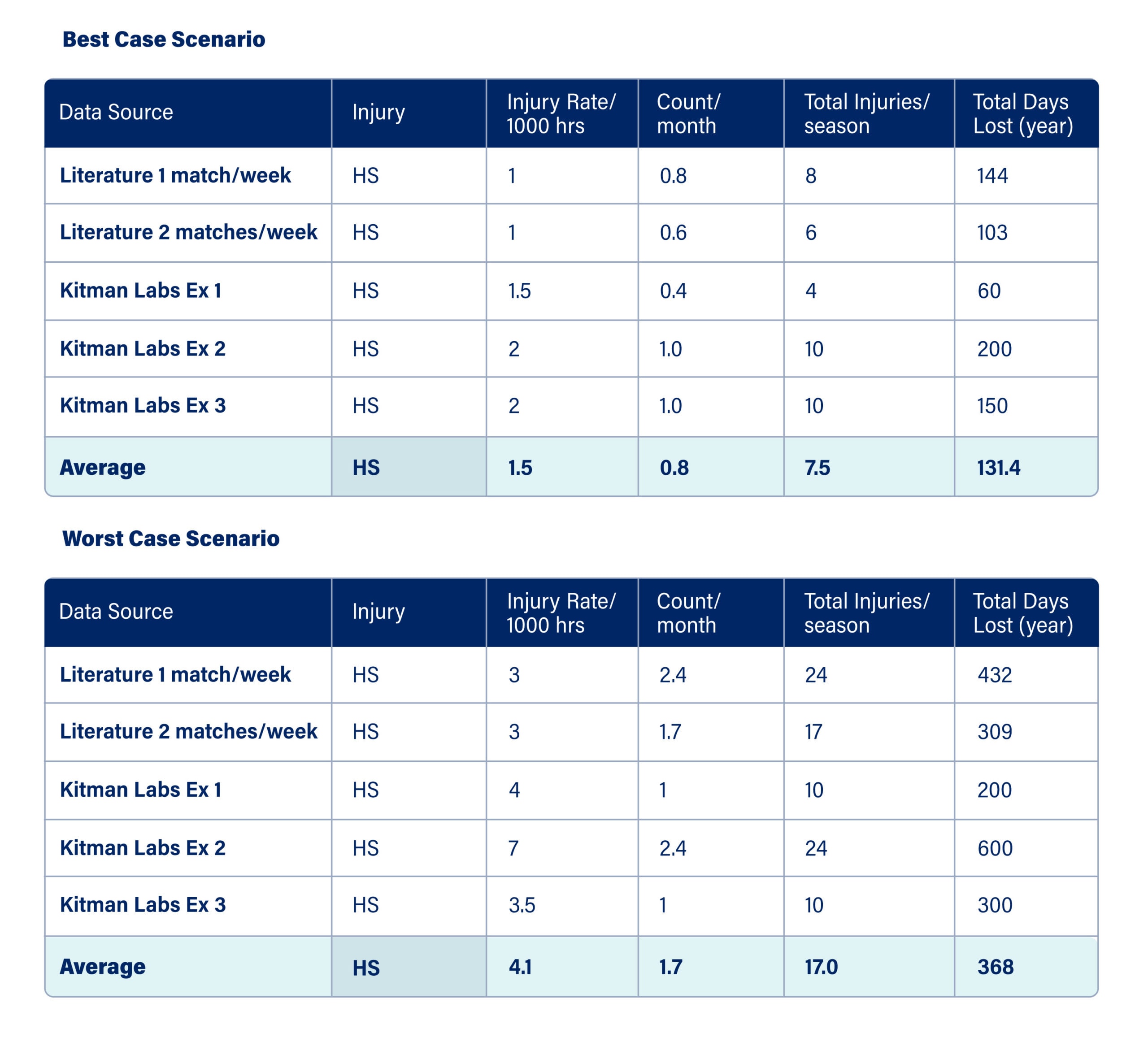In an earlier blog, we explained injury rates in elite football in practical terms so that teams can more easily assess their own injuries within the context of larger studies. In this follow-up post, we provide further insights into the ‘expected’ injury counts per week/month of hamstring strain, which is the most common injury encountered in elite football (soccer) (Ekstrand, 2021).
In addition to providing the potential weekly/monthly injury counts for this specific muscle group, we also take a closer look at the actual burden associated with these injuries, namely the days lost (Bar, 2017). In fact, when we think about the actual burden of injuries for a team both in terms of performance and economics (Eliakim, 2020), it’s really the availability of players that matters. Overall, this is better illustrated by days away from the squad, rather than simply the frequency and occurrences of those injuries.
We have looked at both available benchmarks (Ekstrand, 2021; Whalan, 2019; López-Valenciano, 2020) and data from our work with several teams to provide a range, from best to worst case scenarios. The numbers in terms of injury frequency (turned into monthly counts) and days lost are provided in Table 1.
Table 1. The number of weeks required to reach 1000 hrs of exposure was estimated as previously. A generic average number of 18 days lost (Ekstrand, 2021) was used to calculate burden when using some of the benchmarks. Note the variability of the rates and counts shown, which is likely related to specific team contexts that affect injury risk factors, training, and match exposure.
In conclusion, while there seem to be large variations in relation to context (competition standard, playing 1 vs. 2 matches a week, period of the season, player profiles including age and previous injury history), teams may expect from 1 to 2 hamstring injuries a month—for a total number of days lost of 150 to 350 per year (5 to 12 months).
You can read the full paper Elite football injury risk explained: translating 1000-hour injury rates into expected weekly injury counts here.
References
- Bahr R, Clarsen B, Ekstrand J. Why we should focus on the burden of injuries and illnesses, not just their incidence. Br J Sports Med. 2018 Aug;52(16):1018-1021. doi: 10.1136/bjsports-2017-098160. Epub 2017 Oct 11.
- Ekstrand J., Spreco A., Bengtsson H., Bahr R. Injury rates decreased in men’s professional football: an 18-year prospective cohort study of almost 12,000 injuries sustained during 1.8 million hours of play. Br J Sports Med. 2021 Oct; 55(19):1084-1091. doi: 10.1136/bjsports-2020-103159. Epub 2021 Feb 5.
- Eliakim E., Morgulev E., Lidor R., Meckel Y. Estimation of injury costs: financial damage of English Premier League teams’ underachievement due to injuries. BMJ Open Sport Exerc Med. 2020 May 20; 6(1):e000675. doi: 10.1136/bmjsem-2019-000675. eCollection 2020.
- López-Valenciano A., Ruiz-Pérez I., Garcia-Gómez A., Vera-Garcia FJ, De Ste Croix M., Myer GD, Ayala F. Epidemiology of injuries in professional football: a systematic review and meta-analysis. Br J Sports Med. 2020 Jun;54(12):711-718. doi: 10.1136/bjsports-2018-099577. Epub 2019 Jun 6. PMID: 31171515.
- Whalan M, Lovell R, McCunn R, Sampson JA. The incidence and burden of time loss injury in Australian men’s sub-elite football (soccer): A single season prospective cohort study. J Sci Med Sport. 2019 Jan;22(1):42-47. doi: 10.1016/j.jsams.2018.05.024. Epub 2018 May 31.





